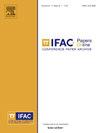双极深脑刺激中的纤维激活:一个患者案例研究
Q3 Engineering
引用次数: 0
摘要
脑深部电刺激(DBS)是一种广泛用于治疗神经系统疾病症状的疗法。在DBS中,电脉冲通过手术植入的电极慢性传递到特定疾病的大脑目标。利用刺激接触构型、刺激极性以及DBS脉冲序列的幅度、频率和脉宽来优化治疗效果。本文以特发性震颤(ET)患者为例,研究了基于患者特异性数学模型的个体化治疗方法。比较了两种计算模型阐明DBS刺激对齿状-丘状丘脑束(DRTT)影响的能力:(i)传统的组织激活体积模型(VTA)和(ii)完善的开源模拟(OSS)神经纤维激活建模框架,称为OSS-DBS。将模拟结果与使用智能手机应用程序在不同DBS设置下测量的患者震颤进行比较。研究结果强调,暂时静态的VTA模型不能充分描述极性转换的双极刺激设置的结果差异,而神经纤维激活模型在这方面具有潜力。然而,值得注意的是,这两种研究模型都不能完全解释所测量的症状模式,特别是关于单侧刺激产生的双边效应。本文章由计算机程序翻译,如有差异,请以英文原文为准。
Fiber Activation in Bipolar Deep Brain Stimulation: A Patient Case Study⁎
Deep brain stimulation (DBS) is a therapy widely used for treating the symptoms of neurological disorders. Electrical pulses are chronically delivered in DBS to a disease-specific brain target via a surgically implanted electrode. The stimulating contact configuration, stimulation polarity, as well as amplitude, frequency, and pulse width of the DBS pulse sequence are utilized to optimize the therapeutic effect. In this paper, the utility of therapy individualization by means of patient-specific mathematical modeling is investigated with respect to a specific case of a patient diagnosed with Essential tremor (ET). Two computational models are compared in their ability to elucidate the impact of DBS stimulation on the Dentato-Rubro-Thalamic tract (DRTT): (i) a conventional model of volume of tissue activated (VTA) and (ii) a well-established, open-source simulation (OSS) neural fiber activation modeling framework known as OSS-DBS. The simulation results are compared with tremor measured in the patient under different DBS settings using a smartphone application. The findings of the study highlight that temporally static VTA models do not adequately describe the differences in the outcomes of bipolar stimulation settings with switched polarity, whereas neural fiber activation models hold potential in this regard. However, it is noted that neither of the investigated models fully accounts for the measured symptom pattern, particularly regarding a bilateral effect produced by unilateral stimulation.
求助全文
通过发布文献求助,成功后即可免费获取论文全文。
去求助
来源期刊

IFAC-PapersOnLine
Engineering-Control and Systems Engineering
CiteScore
1.70
自引率
0.00%
发文量
1122
期刊介绍:
All papers from IFAC meetings are published, in partnership with Elsevier, the IFAC Publisher, in theIFAC-PapersOnLine proceedings series hosted at the ScienceDirect web service. This series includes papers previously published in the IFAC website.The main features of the IFAC-PapersOnLine series are: -Online archive including papers from IFAC Symposia, Congresses, Conferences, and most Workshops. -All papers accepted at the meeting are published in PDF format - searchable and citable. -All papers published on the web site can be cited using the IFAC PapersOnLine ISSN and the individual paper DOI (Digital Object Identifier). The site is Open Access in nature - no charge is made to individuals for reading or downloading. Copyright of all papers belongs to IFAC and must be referenced if derivative journal papers are produced from the conference papers. All papers published in IFAC-PapersOnLine have undergone a peer review selection process according to the IFAC rules.
 求助内容:
求助内容: 应助结果提醒方式:
应助结果提醒方式:


